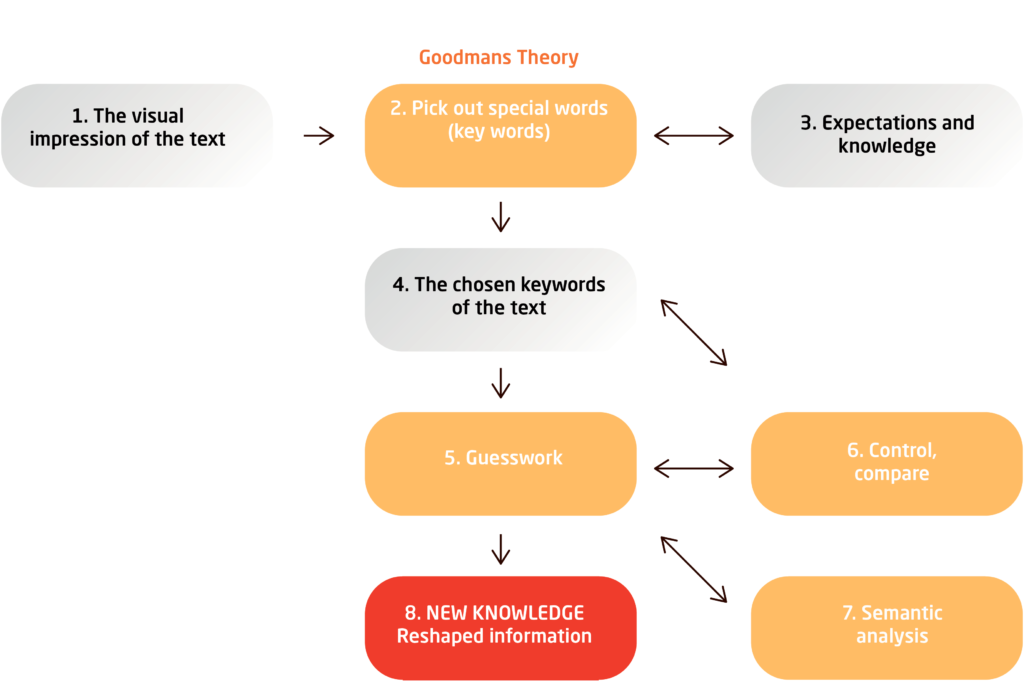The theory behind FrontRead
FrontReads unique training application has been built on a platform of extensive knowledge about reading and learning and is based on methods and results from over 25 years of experience with teaching adults how to improve their reading abilities. Our app and teaching methods are based on theories and studies in fields such as peripheral reading, eye span, the working memory and concentration.
Reading is a relatively new skill in the history of mankind. It is a skill we are still developing. Our reading material grows exponentially and our reading skills need to be able to follow suit. At the same time, our knowledge about the human mind keeps expanding. The American professor in psychobiology, Roger Sperry, won the 1981 Nobel Prize in Physiology and Medicine for his work with split-brain research. A subsequent discovery based on Sperry’s research mapped the upper parts of the brain further and determined that there was a left and right part of the front-brain and that they can communicate with each other when sharing a workload.
Research concerning the brain continually makes new discoveries, but there is still much we don’t know. One thing we can say for certain though is if we wish to exploit our mental capabilities optimally then we need to use both sides of the brain – and that also holds true when reading.
When we read a big part of our speed relies on our eyes and the fact that we often read with an inner voice, which reads the words out loud inside of us. This hinders our active reading speed.
Our eye span is crucial
Even the fastest speakers struggle getting over 260 words per minute. But the brain is more than capable of working with 500-800 words per minute. However, it requires that we use the visual right part of our brain more when we read. FrontRead teaches you to do just that, while at the same time subduing your internal monologue coming from the left side of the brain. A step toward minimizing your inner voice involves increasing the size of your eye span. For example, did you know, that if you widen your eye span to include just one letter more, you can increase your reading speed by up to 39%.*
L E T T E R
LET – TER
LETTER
3-4 WORDS
ENTIRE SENTENCE
The examples above show how it is possible to broaden the eye span. In this way the eyes ability to take in more information at once is expanded. This allows you to absorb larger passages of text at once.
Our eye span is one of the largest bottlenecks when it comes to reading. This is the conclusion of two American professors in the fields of psychology and optometry, Gorden Ernest Legge* and Susana T.L. Chung. Through their research and studies they have discovered that it is possible to improve reading speed by training the eye span. Chung found that the eyes natural span could be expanded through training with a letter recognition exercise. Her conclusion was that following such training not only did reading speed increase, but the subjects had increased text comprehension as well, all of which meant that they were able to remember more of what they had just read..
The holistic theory
One of the most fruitful theories in regards to reading is the holistic theory. “Holistic” is the belief that the whole is more important than the parts, and that the meaning of the parts only can be understood, if one understands the larger picture.

Goodman* believes that when you read as an adult, your consciousness plays a (psycholinguistic) guessing game with the text. In this process, your consciousness has some expectations to the material you are about to read, and when it samples that content it will then search for important words – keywords – that can then either confirm or reject that expectation.
Goodman presented reading as a psycholinguistic guessing game, a process in which readers sample the text, make hypotheses, confirm or reject them, make new hypotheses, and so forth. Here, the reader rather than the text is at the heart of the reading process.
- The first thing to happen when you are about to read a text is that you get a visual impression of the text. You skim it briefly, look at the index, resumes, conclusions etc. At this point you are already starting to form an opinion about the content of the text.
- When you read you are constantly looking for special words (keywords) that your consciousness uses to guess the content of the entire text.
- What keywords you choose, depends on your expectations and your knowledge of the subject. If you are reading a text about how to fix a broken bike, then maybe you just bought a tyre lever. This means that your eyes automatically look for words like “tyre lever” because your consciousness expects an explanation on how to use such a tool. Maybe you’ve never heard about tyre levers before. Then your consciousness would like to know how you remove the tyre and thus searches for words like “dismount tyre”.
- When you have found your keywords you’ll guess or reason your way to the content of the text. For example, if you want to know how you locate the puncture in a deflated tyre, your consciousness starts searching for keywords like: “locate a puncture”, “inflate tyre”, “spin around”.
- Based on these keywords your consciousness makes a qualified guess as to the content of the sentence, and comes to the conclusion that the sentence probably says: “You locate a puncture by inflating the tyre and then spinning the tyre slowly around until you hear the sound of escaping air.”
- During your reading, your consciousness constantly controls that your keywords live up to its expectations of the content.
- When we read, our consciousness controls our sentence construction. If we read something in a foreign language we might experience that our consciousness works on pronunciation as well as reading. This is also the part of our consciousness we use when proofreading something. At the same time this is why we have a tendency to ignore blaring mistakes when proofreading our own texts and material as our consciousness has a prior understanding of the content already, thus skipping over larger parts of the text.
- Through reading a particular text our expectations are adjusted with any recently acquired information. This in turn helps us get a better understanding of the material.
By reading faster and concentrating more we also activate our subconsciousness.
Apart from the conscious brain processes, our mind works with the subconscious sense impressions – even when we read. Our subconsciousness or our unconscious intelligence helps us to associate and relate to the text on a conscious level. Through our “subliminal perception” we find ourselves able to receive a lot more information per second. Put in other words, there is a constant exchange of data between the conscious and the unconscious, this also applies when reading.
-
* Mikkel Wallentin, Master of Arts in the fields of Dramaturgy and Cognitive Semiotics, PH.D., Danish author and neuroscientist * Gordon Ernest Legge is currently the Distinguished McKnight University Professor and former chair of the Department of Psychology at the University of Minnesota. Legge is the director of the Minnesota Laboratory for Low-Vision Research * Susana T.L. Chung, Professor of Optometry at Berkely University in California * Chung STL, Legge GE, Cheung SH. Letter-recognition and reading speed in peripheral vision benefit from perceptual learning. Vision Res 2004; 44(7): 695-709 * Kenneth Goodman, Professor Emeritus, Language Reading and Culture, at the University of Arizona. He is best known for developing the theory underlying the literacy philosophy of whole language

